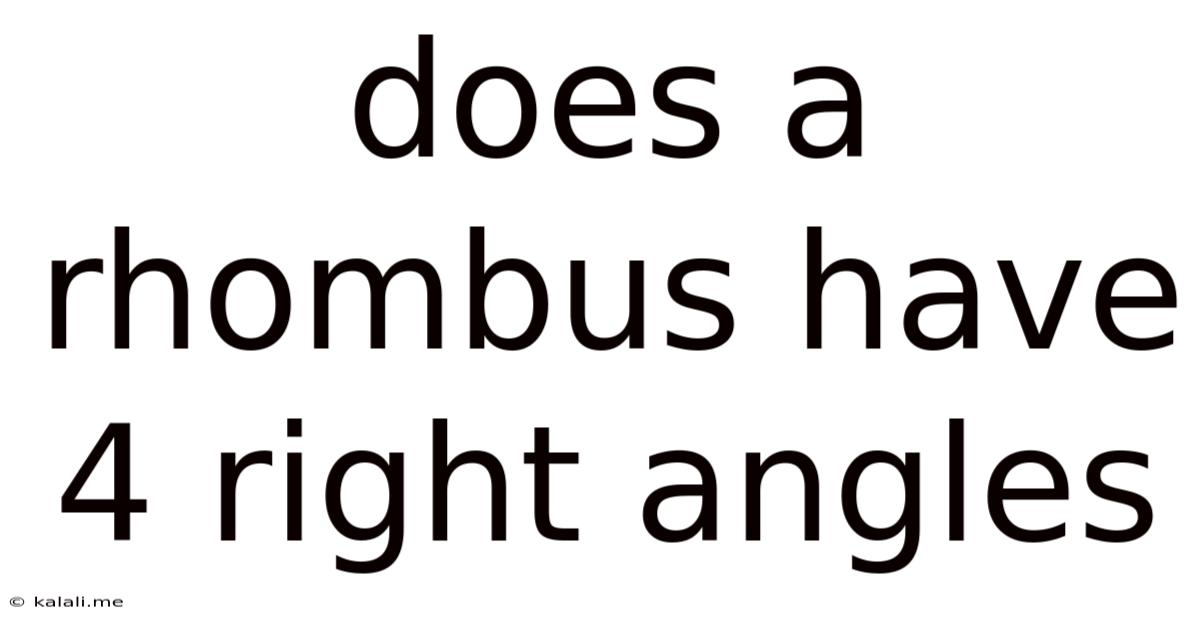Does A Rhombus Have 4 Right Angles
Kalali
Jul 17, 2025 · 5 min read

Table of Contents
Does a Rhombus Have 4 Right Angles? Exploring the Properties of Rhombuses and Squares
This article delves into the fascinating world of quadrilaterals, specifically addressing the common question: does a rhombus have 4 right angles? We will explore the defining characteristics of rhombuses, compare them to squares, and clarify the subtle yet crucial differences between these shapes. Understanding these distinctions is essential for anyone studying geometry or working with geometric concepts in other fields. This comprehensive guide will not only answer the central question but also provide a deeper understanding of the properties of rhombuses and their relationship to other quadrilaterals.
Understanding the Rhombus: A Definition and Key Properties
A rhombus is a quadrilateral, meaning a polygon with four sides. However, it's not just any quadrilateral; it possesses specific properties that set it apart. The defining characteristic of a rhombus is that all four of its sides are equal in length. This property distinguishes it from other quadrilaterals like rectangles, parallelograms, and trapezoids. Beyond equal sides, a rhombus also exhibits several other important properties:
-
Opposite sides are parallel: This means that the opposite sides of a rhombus will never intersect, even if extended infinitely. This parallel characteristic is shared with parallelograms and rectangles.
-
Opposite angles are equal: Just like parallel sides, opposite angles within a rhombus are congruent (equal in measure).
-
Consecutive angles are supplementary: This means that any two angles next to each other (consecutive) add up to 180 degrees. This property is also shared with parallelograms.
-
Diagonals bisect each other: The diagonals of a rhombus (the lines connecting opposite corners) intersect at a point that divides each diagonal into two equal segments. Furthermore, these diagonals intersect at a right angle, creating four right-angled triangles within the rhombus.
-
Diagonals bisect the angles: Each diagonal divides its corresponding angles into two equal angles.
The Relationship Between Rhombuses and Squares: A Closer Look
Now, let's address the core question of whether a rhombus possesses four right angles. The answer is: not necessarily. While a rhombus has many properties, having four right angles is not one of them. This is where the square comes in. A square is a special type of rhombus – a rhombus with an added condition.
A square is defined as a quadrilateral with four equal sides and four right angles. Therefore, all squares are rhombuses (because they satisfy the rhombus definition of equal sides), but not all rhombuses are squares (because they don't necessarily have right angles). The relationship can be visualized using a Venn diagram, with the set of squares completely contained within the set of rhombuses.
Why a Rhombus Doesn't Always Have 4 Right Angles: A Visual Explanation
Imagine drawing a rhombus. You could start by drawing two equal-length lines that intersect at an angle. Then, complete the rhombus by drawing two more equal-length lines parallel to the first two. You can clearly see that the angles formed can be different values. Unless you specifically construct the rhombus with 90-degree angles, it will not be a square.
Consider a rhombus with angles of 60, 120, 60, and 120 degrees. This shape clearly satisfies the condition of having four equal sides but does not have four right angles. Similarly, a rhombus with angles of 70, 110, 70, and 110 degrees also fulfills the definition of a rhombus without possessing any right angles.
Exploring Different Types of Rhombuses:
To further illustrate this concept, let's consider different types of rhombuses based on their angles:
-
Square Rhombus: This is a rhombus with all four angles equal to 90 degrees. It's essentially a square.
-
Oblique Rhombus: This is a rhombus where none of the angles are equal to 90 degrees. The angles are unequal, resulting in a shape that is tilted or slanted. This is the most common type of rhombus.
-
Rhombus with two right angles: While a rhombus cannot have just one or three right angles, it is theoretically possible to have a rhombus with exactly two right angles. However, this would also imply that the other two angles are 180 degrees, which is impossible in a closed shape.
Practical Applications and Real-World Examples
Understanding the properties of rhombuses and their differences from squares has practical implications in various fields:
-
Engineering: The structural properties of rhombuses are utilized in constructing stable and efficient frameworks. The ability to create rigid structures with non-right-angled rhombuses allows for flexibility in design.
-
Architecture: The shape of a rhombus can be seen in many architectural designs, offering aesthetic appeal and structural integrity.
-
Art and Design: Rhombuses frequently appear in artwork, textiles, and graphic design, adding visual interest and dynamism.
-
Game Design: Understanding the geometric properties of rhombuses is crucial in developing realistic game environments and physics simulations.
Conclusion: A Clear Distinction
In summary, a rhombus does not necessarily have four right angles. While all squares are rhombuses, the converse is not true. The defining characteristic of a rhombus is its four equal sides, while the defining characteristics of a square are four equal sides and four right angles. Understanding this distinction is fundamental to grasping the properties and applications of these important geometric shapes. This knowledge is vital for various fields requiring a strong grasp of geometric principles, from engineering and architecture to art and design. The subtle but crucial difference between a rhombus and a square highlights the importance of precise definitions and careful consideration of geometric properties.
Latest Posts
Related Post
Thank you for visiting our website which covers about Does A Rhombus Have 4 Right Angles . We hope the information provided has been useful to you. Feel free to contact us if you have any questions or need further assistance. See you next time and don't miss to bookmark.